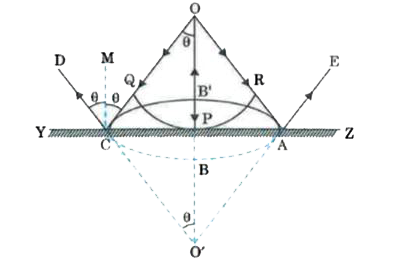You have learnt in the text how Huygens’ principle leads to the laws of reflection and refraction. Use the same principle to deduce directly that a point object placed in front of a plane mirror produces a virtual image whose distance from the mirror is equal to the object distance from the mirror.
In the figure given below, let O be a point object that is placed in fromt of the plane mirror YZ, at a normal distance of OP from it.
From point O, the spherical wavefront originates. One part QPR of the wavefront touches the plane mirror at point P. The optical disturbances from points Q and R proceed forward along the rays OQ and OR, respectively, but from point P it reflects back . At the instant of time when the disturbances from points Q and R reach the mirror at points C and A, respectively , the disturbance from point P reaches B.. In this way, reflected spherical wavefront CB.A is formed. In the figure, CBA (shown as dashed) shows position of the wavefront if there were no mirror present.

It seems that the reflected wavefront CB.A starts from point O.. So O. becomes virtual point image for point object O.
Draw CM, normal to YZ, hence parallel to PO.
Refer to the figure, OC is the incident ray (as it is perpendicular to the incident wavefront CBA) and CD is reflected ray (as it is perpendicular to the incident wavefront CB.A).
Hence, ∠OCM=∠DCM=θ(∴i=r)
But ∠OCM=∠COP (alternate angles)
and ∠DCM=∠CO.P (corresponding angles)
∠COP=∠CO.P
Now in triangles CO.PandCOP,
∠CO.P=∠COP(each=θ)
∠CPO.=∠CPO(each=90∘)
CP is common to both the triangles. Thus, triangules CO.P and COP are congruent.
Hence, PO.=PO
This means that the normal distance of the object and the image from the mirror are equal.
Topper's Solved these Questions
- WAVE OPTICALBOOK - MODERN PUBLICATIONCHAPTER - WAVE OPTICALEXERCISE - NCERT (EXemplar Problems Obejective Questions) (Multiple Choice Questions (Type-I)
5 Videos
- WAVE OPTICALBOOK - MODERN PUBLICATIONCHAPTER - WAVE OPTICALEXERCISE - NCERT (EXemplar Problems Obejective Questions) (Multiple Choice Questions (Type-II)
4 Videos
- WAVE OPTICALBOOK - MODERN PUBLICATIONCHAPTER - WAVE OPTICALEXERCISE - NCERT FILE SOLVED (TEXT BOOK EXERCISES)
10 Videos
- SEMICONDUCTOR ELECTRONICS METERIALS DEVICES AND SIMPLE CIRCUITS BOOK - MODERN PUBLICATIONCHAPTER - SEMICONDUCTOR ELECTRONICS METERIALS DEVICES AND SIMPLE CIRCUITS EXERCISE - CHAPTER PRACTICE TEST FOR BOARD EXAMINATION
12 Videos
Similar Questions
You have learnt in the text how Huygens’ principle leads to the laws of reflection and refraction. Use the same principle to deduce directly that a point object placed in front of a plane mirror produces a virtual image whose distance from the mirror is equal to the object distance from the mirror.
View SolutionUse mirror equation to deduce that an object placed between the pole and focus of a concave mirror produces a virtual and enlarged image.
View Solution
Knowledge Check
The distance of the image from the mirror is _______ as/ the distance of the object from the mirror.
ALesser thanBGreater thanCSameDDifferentAn object is placed at a distance of 10 cm in front of a plane mirror, then the distance of image from mirror is:
A5 cmB10 cmC20 cmD0An object is placed 10 cm in front of a convex mirror of focal length 20 cm . The distance of the image from the mirror is
A10/3 cmB20/3 cmC10 cmD40/3 cm
If an object is placed at a distance of 0.5 m in front of a plane mirror, the distance between the object and the image formed by the mirror will be:
View SolutionA concave mirror of focal length f produces a real image n times the size of the object. The distance of the object from the mirror is
View SolutionAn object is placed in from of a convex mirror of focal length 50 cm, if the image is one fourth the size of the object, the distance of the image from the mirror is
View SolutionA toy car is placed at 15 cm in the front of the plane mirror. What is the distance of the image from the mirror?
View SolutionAn object is placed at a large distance in front of a convex mirror of radius of curvature 40 cm . What is the distance of image from the mirror ?
View Solution
